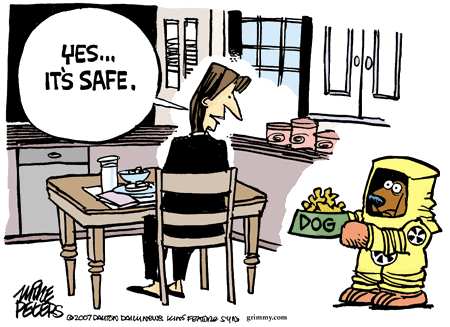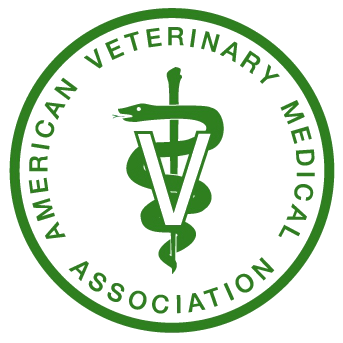Way before the advent of commercial pet food, dogs lived off of a raw diet as they hunted and foraged for their food in the wild. Bacteria and disease was not cause the species to die out. They thrived off of their diets.
I spoke to Melinda Miller who kindly provided me with information about salmonella and the concern regarding raw diets for dogs. Ms. Miller is the president of the North American Raw Pet Food Association and the Director of the prestigious Smith Ridge Veterinary Center in South Salem, NY. Smith Ridge was founded by Dr. Marty Goldstein who is the author of “The Nature of Animal Healing.”
Ms. Miller explained to me that salmonella is part of the natural flora within a dog’s system. She stated that 36% of dogs carry a sub-clinical presence of salmonella. This means that the amount of salmonella was not significant enough to cause any sickness. Ms. Miller also pointed out that it is uncom mon for dogs to become ill from salmonella. Dogs who have compromised immune systems are sometimes at risk, but again, the risk is minimal. The concern with regard to salmonella is the mere transfer of the bacteria to humans. For example, if your dog licks your mouth after eating raw poultry, meat or fish, there is a risk that the bacteria will transfer to you. If your dog has the salmonella bacteria on his hair and you pet your dog in that location, the bacteria will get onto your hands. If your hand makes contact with your mouth then it is possible that you will become infected.
mon for dogs to become ill from salmonella. Dogs who have compromised immune systems are sometimes at risk, but again, the risk is minimal. The concern with regard to salmonella is the mere transfer of the bacteria to humans. For example, if your dog licks your mouth after eating raw poultry, meat or fish, there is a risk that the bacteria will transfer to you. If your dog has the salmonella bacteria on his hair and you pet your dog in that location, the bacteria will get onto your hands. If your hand makes contact with your mouth then it is possible that you will become infected.
Stated in the Journal of American Veterinary Medical Association, “Surveys have disclosed that over 20% of the dogs in a population may be infected. Non-clinical salmonellosis occurs in most cases.” This confirms what Ms. Miller described above.
Not only do dogs have a shorter small intestine than humans, their large intestines only consists of the cecum, colon, and the rectum. Dogs’ stomach acids are far more efficient in breaking down components of food than humans. Not only do dogs have relatively shorter intestines than humans, but a dog’s intestines work more efficiently than their human counterparts. Food makes its journey through a dog’s digestive system more rapidly than that it does in a human body. Toxins spend less time lingering in the dog’s intestines. Food does not need to travel through a human-like large intestine waiting for its waste material to be released.
Raw food contains active enzymes that are not present in processed foods. Those enzymes serve an important role in the digestion of raw nutrients. In other words, by design, dogs physically suited to consume a raw diet as nature intended. Because wild dogs and domesticated dogs are the same exact species, they have the same physical make up.
Kibble and wet dog food do not contain digestive enzymes that raw meat contain so commercial processed dog food remains in a dog’s system for a longer time than raw food does. Digestive enzymes are also produced when the liver and the pancreas are stimulated which makes for speedier digestion. Therefore, toxins remain in dogs for a longer period of time because they are not digested as efficiently as raw products.
Now let’s talk about thee toxicity of raw proteins. How do we prepare our raw protein before we eat it? We cook it! High temperatures are proven to kill salmonella. Kibble is cooked at  extremely high temperatures which kills the salmonella. Not only does this process kill salmonella, but it kills virtually all nutrients. Therefore, commercially prepared processed dog food must be fortified or enriched with nutrients. If you look at the bottom of most non-raw dog food labels you will find a list of vitamins and minerals. They are applied to the food AFTER the cooking process What are they and where do they come from? The vitamins and minerals that are added are called, vitamin premix which is anything but healthy. If there are more than you can count on one hand, then you can be sure that those supplements have been bulked together and produced in China. China has cornered the market on the production of premix products. The FDA does not require manufacturers to disclose where the ingredients come from. Due to our concerns about China, many labels state boldly on their labels that their product is manufactured in the USA with no mention about where the ingredients come from. Also, even if a manufacturer states that they use ingredients that are from the USA, they don’t need to specify which ones are and which ones are not from the USA. For example, if there are 5 ingredients that come from the USA, they can claim that their products use ingredients from the USA which implies that the products are not from sources outside of the USA. So if salmonella is present in dogs and they are not dying off in the wild, then what could it be? Isn’t it reasonable to consider that premix or other additives might be responsible? In 2007, melamine and cyanuric acid had been found in these vitamin premixes and caused an alarming number of dogs and cats to become ill and die. Do we really know what China is doing to the ingredients?
extremely high temperatures which kills the salmonella. Not only does this process kill salmonella, but it kills virtually all nutrients. Therefore, commercially prepared processed dog food must be fortified or enriched with nutrients. If you look at the bottom of most non-raw dog food labels you will find a list of vitamins and minerals. They are applied to the food AFTER the cooking process What are they and where do they come from? The vitamins and minerals that are added are called, vitamin premix which is anything but healthy. If there are more than you can count on one hand, then you can be sure that those supplements have been bulked together and produced in China. China has cornered the market on the production of premix products. The FDA does not require manufacturers to disclose where the ingredients come from. Due to our concerns about China, many labels state boldly on their labels that their product is manufactured in the USA with no mention about where the ingredients come from. Also, even if a manufacturer states that they use ingredients that are from the USA, they don’t need to specify which ones are and which ones are not from the USA. For example, if there are 5 ingredients that come from the USA, they can claim that their products use ingredients from the USA which implies that the products are not from sources outside of the USA. So if salmonella is present in dogs and they are not dying off in the wild, then what could it be? Isn’t it reasonable to consider that premix or other additives might be responsible? In 2007, melamine and cyanuric acid had been found in these vitamin premixes and caused an alarming number of dogs and cats to become ill and die. Do we really know what China is doing to the ingredients?
Salmonella presents an issue to humans. The FDA has cited more dangers of dog food when it comes to its affect on people. People often handle dog food carelessly and become ill as a result. What does salmonella in dog food have anything to do with people becoming infected? Many dog owners handle dog food differently than they would handle raw food. When we cook raw proteins, it is obvious to most people that we need to sanitize bowls, countertops, and wash our hands. When people (particularly children) handle dog food that has salmonella and neglect to practice appropriate cleaning afterwards, the salmonella is likely to be transferred from the dog food and inadvertently consumed. I spoke to David Steigman who works in the communications department within the Office of Food and Veterinary Medicine of the US Food and Drug Administration. I asked him questions and he kindly researched and provided some answers for me. I inquired about the FDA’s concern with salmonella causing illness in dogs. In his email, he stated “the FDA believes regulatory action is warranted in cases involving pet foods contaminated with salmonella due to the heightened human health risk given the high likelihood of human contact with such food.” Furthermore, when I asked about raw meat, he stated “The FDA’s concern with raw meat food for animals stems from the goal of protecting the public from significant food borne illness health risks, particularly when raw pet food products are brought into the home or used to feed domestic pets.” I asked him if studies were done using raw food that is prepared properly (frozen then defrosted for a day in the refrigerated as opposed to being left on the countertop for a few weeks). Of course fresh kill may be fed immediately, but raw food from the grocery store must be refrigerated and properly handled prior to serving; it shouldn’t be left on the counter for long periods of time. Surprisingly, he reported to me that there haven’t been any studies that have examined the effects of meat when preparation is taken into account and he was not aware of whether or not such studies have been published and he was not aware of any such studies being performed by the FDA. It could be deduced that the FDA is not testing specifics, and not testing raw meat versus overprocessed dog food products from large commercial manufacturers. Raw meat has contains important enzymes which kibble and canned dog food does not have. According to Mr. Steigman, the FDA has not done any studies that take this into consideration. Are they using acceptable standards in their studies? Mr. Steigman asked me what I thought about contacting the FDA’s website and inquiring about the scientific integrity or their studies. Let’s say that all of the food products for dogs have some degree of salmonella, we can make that a standard in an argument. Now that a standard trend is brought to light, can we consider that it could be a different issue that is causing illness in dogs? For centuries we haven’t had these issues with dogs eating raw food. Dogs have been ok with eating food that has salmonella contamination (unless their immune system is compromised). If a dog’s system could not handle salmonella, then here is NO way dogs could eat garbage including poop (which often contains salmonella) and not contract illness to the degree that this salmonella scare is causing. Years ago, dog food was fortified with nutrients that were not tainted with melamine and other toxins that have originated in China. I have fed my dogs a raw diet for many years. My article What I Feed My Own Dogs describes what I have used.
prepared properly (frozen then defrosted for a day in the refrigerated as opposed to being left on the countertop for a few weeks). Of course fresh kill may be fed immediately, but raw food from the grocery store must be refrigerated and properly handled prior to serving; it shouldn’t be left on the counter for long periods of time. Surprisingly, he reported to me that there haven’t been any studies that have examined the effects of meat when preparation is taken into account and he was not aware of whether or not such studies have been published and he was not aware of any such studies being performed by the FDA. It could be deduced that the FDA is not testing specifics, and not testing raw meat versus overprocessed dog food products from large commercial manufacturers. Raw meat has contains important enzymes which kibble and canned dog food does not have. According to Mr. Steigman, the FDA has not done any studies that take this into consideration. Are they using acceptable standards in their studies? Mr. Steigman asked me what I thought about contacting the FDA’s website and inquiring about the scientific integrity or their studies. Let’s say that all of the food products for dogs have some degree of salmonella, we can make that a standard in an argument. Now that a standard trend is brought to light, can we consider that it could be a different issue that is causing illness in dogs? For centuries we haven’t had these issues with dogs eating raw food. Dogs have been ok with eating food that has salmonella contamination (unless their immune system is compromised). If a dog’s system could not handle salmonella, then here is NO way dogs could eat garbage including poop (which often contains salmonella) and not contract illness to the degree that this salmonella scare is causing. Years ago, dog food was fortified with nutrients that were not tainted with melamine and other toxins that have originated in China. I have fed my dogs a raw diet for many years. My article What I Feed My Own Dogs describes what I have used.
Stated by the Journal of American Veterinary Medical Association, “Salmonella-contaminated foods that have not been refrigerated or foods that have been allowed to remain in the  dog’s feeding bowl may provide a typical food poisoning episode for the animal.” This confirms that improper storage of raw food is an integral part of the issue with dogs being affected by the bacteria. Dogs bodies can deal with salmonella to a degree, but when in extreme concentrations (due to carelessness), dogs may become very ill. The journal article further states that “A ‘food poisoning’ episode of salmonellosis may be precipitated when dog foods containing small numbers of salmonellae are hydrated and left at room temperature. The bacteria soon multiply to numbers sufficient to cause infection.” With regard to raw or undercooked dog food, “Room temperature incubation for several hours in the canine feeding dish may be sufficient to produce the food poisoning episode.”
dog’s feeding bowl may provide a typical food poisoning episode for the animal.” This confirms that improper storage of raw food is an integral part of the issue with dogs being affected by the bacteria. Dogs bodies can deal with salmonella to a degree, but when in extreme concentrations (due to carelessness), dogs may become very ill. The journal article further states that “A ‘food poisoning’ episode of salmonellosis may be precipitated when dog foods containing small numbers of salmonellae are hydrated and left at room temperature. The bacteria soon multiply to numbers sufficient to cause infection.” With regard to raw or undercooked dog food, “Room temperature incubation for several hours in the canine feeding dish may be sufficient to produce the food poisoning episode.”
The Journal article also states that “Products containing meat meal (12.5% to 25%) most frequently yielded salmonellae.” As it is, “meal” products are rendered. You cam read about what rendered products are all about and what your dog is eating in my article, What’s Really in Dog Food.
Maybe the FDA should restrict our purchases on raw meat. After all, by the same principle, raw meat contains salmonella and humans might not was and sanitize after handling it. Maybe pet turtles should be outlawed because they carry salmonella and a person might handle such a pet and become contaminated and become ill from salmonella. Is common sense such a rare commodity that the FDA feels the urgency to make restrictive legislation? Why not require the dog food industry to put a caution label onto their dog food packaging that warns people of the dangers of ignoring hygiene. This would be similar to signage in restaurant bathrooms demanding that staff wash hands. What’s this country coming to?
Sources:
| Erskine V. Morse, DVM, PhD, and Margo A. Duncan (November 1, 1975). Canine Salmonellosis: Prevalence, Epizootiology, Signs, and Public Health Significance: Journal of American Veterinary Medical Association Vol. 167 (Issue 9) Pages 817-818.
Miller, Melinda. Telephone interview. 4 Feb. 2014Miller, Melinda. Email interview. 4 Feb. 2014. Steigman, David. Telephone interview. 13 Jan. 2014.Steigman, David. Email interview. 6 Feb. 2014. |
Essentiallydogs.com is an educational resource, and all information herein is strictly for educational purposes. It is not intended to diagnose, treat, prevent, or cure disease, nor is it meant to replace the (prescribed) veterinary treatment. Always inform your veterinarian or healthcare provider of any products that your pet is taking, including herbal remedies and supplements. Please do plenty of research so that you may equip yourself with the knowledge necessary to be an effective advocate for your dog’s well-being.









2 thoughts on “Salmonella: What’s the Truth?”
Pingback: RAW Food and Salmonella | Big Dog Pet Foods
Hi there-
Thank you so much for commenting.
Your point is on target! However, there are many sources (that are supposed to be reliable) that state that salmonella is a danger to our pets as well. Much of that information is influenced by commercial pet food lobbyists… The key is to not allow a dog to lick your mouth. I am curious if there have been any studies performed to find out how many people contract salmonella poisoning from being licked by a dog. I am not implying that it isn’t possible, but I just never heard of any studies. We all know that dogs lick their privates, Hey, some dogs eat poop! People need to make sure that they take that into consideration before allowing a dog’s tongue to meet a person’s lips. YUCK!!!
Now when you make yourself fresh chicken, isn’t it a good idea to keep things clean after preparation? You need to clean up each surface that the raw chicken make contact with. It is very important to was your hand as well. I think it is a sad state of affairs when people can’t use common sense and simply wash their hands after handling kibble or anything else.
Nobody can deny that there are far more toxins found in commercial non-raw diets (i.e., aflatoxins, mycotoxins…). Let’s not mention the ingredients. There are MANY recalls of kibble for salmonella (even with all that processing). There is such fright over salmonella in biologically appropriate food, but other types of bacteria are not an issue as in raw. Hmmm…
Too many people are misinformed and believe that salmonella will make their dogs ill (or even kill their dogs).
Thank you so much for checking out my website and for commenting.